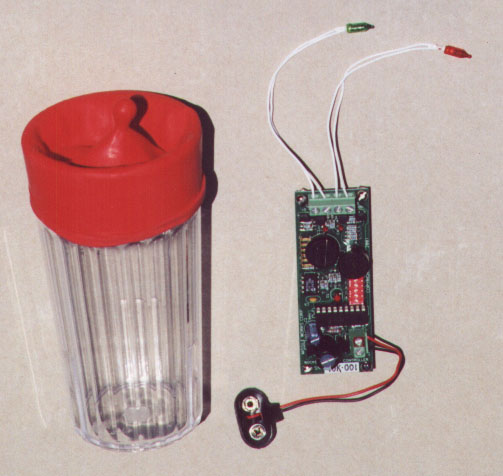Barometric Altimeter Tester
 |
- 1 set of miniature lamps 12 volts 60 mA (Radio Shack part # 272-1000) abt $1.50
- 1 clear plastic drinking glass
- 1 punchball balloon
- 1 altimeter

(Altimeter shown is an RRC�X by Missile Works)
Attach one color of matchbook sized miniature lamp to the drogue output of the altimeter and another color to the main output. Cut off the end of the punchball balloon near the mouth of the balloon so that if will fit over the mouth of the cup without much difficulty. Arm the altimeter and place it in the glass with a cardboard separator if necessary to keep the battery away from the altimeter circuitry. Place the balloon over the glass on such a way that it is loose but not protruding significantly from the glass. Pull on the balloon with increasing force to simulate lift-off and ascent. When you decrease the pull on the balloon even momentarily, the altimeter should sense apogee and fire the drogue output. As you continue to decrease the force, the pressure will increase inside the glass and should eventually fire the main output. If the mouth of the glass is not much over 3", you should have little difficulty in simulating altitudes over 2,000 ft.
If your altimeter requires a rapid decrease in altitude to arm, begin your pull quickly.
It is a good idea to solder the extremely small lamp wires to 22 gauge or larger stranded wire and tin the exposed tips for ease of use. Heat shrink should cover the joint to keep the wire from breaking there.
Submitted by Charles Barnett
